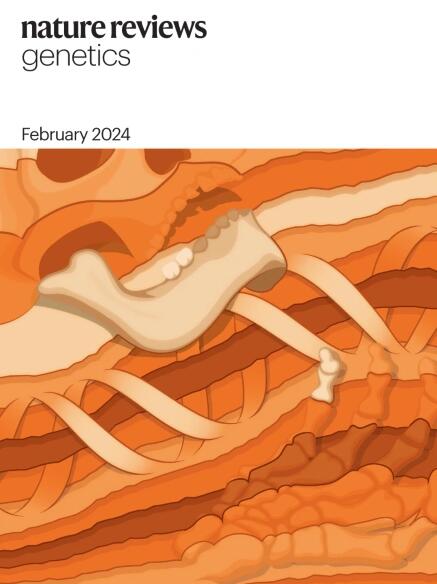利用遗传学了解 ADAR1 介导的 RNA 编辑在健康和疾病中的作用
IF 52
1区 生物学
Q1 GENETICS & HEREDITY
引用次数: 0
摘要
内源性长双链 RNA(dsRNA)与病毒性 dsRNA 相似,可被细胞膜 dsRNA 传感器识别,从而引发自身免疫。对罕见遗传性人类疾病的基因研究以及使用小鼠模型进行的实验证实,由作用于 RNA 1 的腺苷脱氨酶(ADAR1)进行的腺苷转肌苷 RNA 编辑非常重要,是防止细胞 dsRNA 引起自身炎症反应的关键保障。最近,人类基因研究发现,dsRNA 编辑和感应机制参与了常见的炎症性疾病,强调了 dsRNA 在调节免疫反应和疾病发病机制中的广泛作用。这些发现凸显了靶向 dsRNA 编辑和感应的治疗潜力,ADAR1 抑制剂在癌症治疗中的出现就是例证。本文章由计算机程序翻译,如有差异,请以英文原文为准。


Leveraging genetics to understand ADAR1-mediated RNA editing in health and disease
Endogenous, long double-stranded RNA (dsRNA) can resemble viral dsRNA and be recognized by cytosolic dsRNA sensors, triggering autoimmunity. Genetic studies of rare, inherited human diseases and experiments using mouse models have established the importance of adenosine-to-inosine RNA editing by the enzyme adenosine deaminase acting on RNA 1 (ADAR1) as a critical safeguard against autoinflammatory responses to cellular dsRNA. More recently, human genetic studies have revealed that dsRNA editing and sensing mechanisms are involved in common inflammatory diseases, emphasizing the broader role of dsRNA in modulating immune responses and disease pathogenesis. These findings have highlighted the therapeutic potential of targeting dsRNA editing and sensing, as exemplified by the emergence of ADAR1 inhibition in cancer therapy. ADAR1-mediating RNA editing enables the cell to distinguish between endogenous and viral RNA. Li and Walkley review findings from human and mouse genetics that have revealed the mechanisms of ADAR1-mediated RNA editing, which are now providing insights for the development of potential therapies that target these mechanisms.
求助全文
通过发布文献求助,成功后即可免费获取论文全文。
去求助
来源期刊

Nature Reviews Genetics
生物-遗传学
CiteScore
57.40
自引率
0.50%
发文量
113
审稿时长
6-12 weeks
期刊介绍:
At Nature Reviews Genetics, our goal is to be the leading source of reviews and commentaries for the scientific communities we serve. We are dedicated to publishing authoritative articles that are easily accessible to our readers. We believe in enhancing our articles with clear and understandable figures, tables, and other display items. Our aim is to provide an unparalleled service to authors, referees, and readers, and we are committed to maximizing the usefulness and impact of each article we publish.
Within our journal, we publish a range of content including Research Highlights, Comments, Reviews, and Perspectives that are relevant to geneticists and genomicists. With our broad scope, we ensure that the articles we publish reach the widest possible audience.
As part of the Nature Reviews portfolio of journals, we strive to uphold the high standards and reputation associated with this esteemed collection of publications.
 求助内容:
求助内容: 应助结果提醒方式:
应助结果提醒方式:


